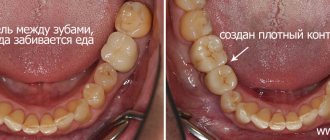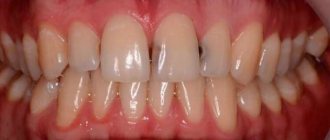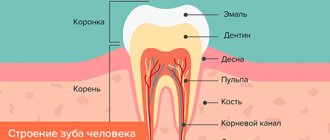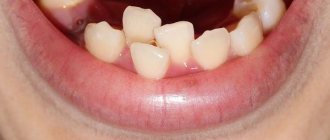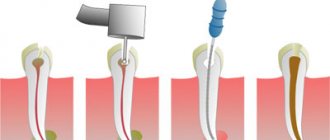Many parents are concerned about the question: how to remove the gap between the child’s teeth, especially in cases where it causes problems with diction? And this is absolutely correct, because if you leave everything as it is and do not remove the gap between the teeth, then in the future it may cause serious and unpleasant problems. That is why diastema (that’s what doctors call the gap) should be resolved in childhood. It is known that the bone tissue in children is not yet fully formed, so any manipulations to correct the position of the teeth are faster and easier to tolerate at an early age.
If the diastema, or gap between your child’s teeth, is pronounced, schedule your child to see a Mira dentist for a consultation. The doctor will talk about the causes of this phenomenon, possible consequences, as well as ways to eliminate the gap.
The causes of diastema are controversial. There are a number of hereditary genetic prerequisites for the occurrence of a large distance between the front teeth. Also, some features of the structure of the oral cavity directly affect the occurrence of diastema: a defect in the frenulum of the lips, large interdental papillae, problems with the replacement of baby teeth with permanent ones, incorrect position of the teeth, pathologies of the teeth and gums.
As a rule, regular dental care from the first months of a baby’s life helps to avoid the formation of a large gap between the teeth - a diastema. In addition, it is very important to monitor the child’s oral hygiene and promptly teach him to take care of his teeth on his own. To prevent dental problems, it is recommended to pay attention to a proper diet rich in vitamins. This will protect the baby from the development of possible pathologies, prevent caries and avoid periodontitis, which are very likely with the appearance of a gap.
Gap between teeth - diastema
Diastema is a fairly common phenomenon. In adults, you can often notice a gap, expressed to a greater or lesser extent. Statistics show that literally every second baby is at risk of developing a gap between the front teeth.
If the gap between the upper or lower front teeth is more than 1 mm and varies in width up to 10 mm (most often the limit is 2–6 mm), we can confidently speak of a diastema. The spaces between other teeth have another name - trema.
Due to the formation of a gap, all sorts of inconveniences arise in the implementation of everyday and vital functions. Diastema complicates the normal process of eating and affects diction, so if there is a sufficiently pronounced gap, the child speaks poorly. In addition, the gap is an additional stimulus for the occurrence of caries and periodontitis.
There is a classification of diastemas, including false ones: this involves the presence of a gap between the baby teeth, which naturally disappears during the change of teeth to molars.
If a gap occurs after the appearance of permanent teeth, measures should be taken to eliminate it as soon as possible. And although dentists eliminate diastema even in adulthood, it is most comfortable to carry out treatment in childhood.
What kind of gap could there be? The main division assumes the existence of symmetrical and asymmetrical diastemas. In the first case, the upper or lower incisors are at an equal distance from each other. In the second, only one tooth has an incorrect position, while the second remains in its rightful place.
Also, the spaces between the teeth can be conditionally divided according to the direction of growth of the incisors. The gap can be caused by the divergence of the incisors in different directions with parallel roots (lateral deviation of the crowns) or by a divergence starting from the roots (corpus lateral displacement).
In addition, a so-called medial tilt is possible, when teeth grow with rotation around their axis or have a clear direction to the side.
Is diastema dangerous?
Parents of young patients who have a gap between their front teeth are concerned about the significance of this phenomenon for the health and condition of the oral cavity.
And indeed, there are negative consequences. Noticeable gap in the dentition:
- worsens diction, which in some cases becomes an obstacle to professional activity;
- creates conditions for spitting out saliva during conversation;
- promotes the deposition of tartar along the edges of the defect and the occurrence of caries;
- causes psychological discomfort due to violation of aesthetics.
Ways to correct a gap between a child's teeth
Eliminating diastema is not so difficult. The many ways to correct gaps between a child's teeth give parents and dentists a wide range of choices. Depending on the width of the gap, individual characteristics and financial capabilities, correcting the anomaly will take some time (from 1 procedure to several years). Among the treatment options for diastema, you will see the most common dental procedures. So, below we present a list of methods for returning teeth to their natural healthy position.
Braces are considered the most common and widely available way to correct a malocclusion. Gradual straightening of the teeth allows the gap to be eliminated. It is best to install braces in childhood, since bone tissue is at the stage of formation and is easier to change. If you install braces in adulthood, you need to be prepared for the fact that after completing the course of wearing braces, you will need to wear a retainer for a long time to consolidate the effect and rebuild muscle memory.
Braces to eliminate gaps between the front incisors are a safe and gentle way to achieve a beautiful, straight smile.
Another way to correct the position of teeth is plates . They belong to the category of removable structures and are designed mainly to be worn by children under 12 years of age. The removable nature of the plates simplifies the process of orthodontic treatment compared to braces, however, if the gap between the incisors is large, the plates will not bring the desired effect.
mouthguards are the dream of many patients, because they are made of transparent material individually in each case and are designed to be worn for several hours a day. Clear aligners have the same effect as braces and plates, but are not suitable for severe overbites.
Another method is to install veneers and crowns on the front teeth. This solution to the problem of diastema does not require a long process of correcting the bite. In this case, the dentist selects a shade of veneers that completely matches the natural shade of the patient’s tooth enamel, which makes the teeth straight and well-groomed, closing the unaesthetic gap. Before installing veneers, you will have to carry out some preparatory work - grinding the teeth.
If the diastema is mild, the dentist may suggest improving the quality of your smile with a cosmetic filling that reduces the gap between the teeth. There is a more aesthetic and modern way to eliminate the gap - artistic restoration. It consists of building up teeth using a composite filling material. After such procedures, care must be taken when chewing hard food and actively using the front teeth while eating.
If the cause of the diastema is an anomaly in the frenulum of the upper lip, an operation to plasticize it is necessary, and then correct the position of the teeth or mask the gap in any way.
Adhesive treatment method
The peculiarity of adhesive dentistry lies in the installation of lumineers, which, similar to veneers, gradually reduce crevices. Lumineers are plates of composite resins of minimal thickness, made to the shape of a cleft in a particular person’s teeth. Any lumineers are made only to order and are given a shade similar to the adjacent areas of the patient’s enamel. This allows you to give the smile of a particular person the most natural look.
Closing gaps using the adhesive method is the fastest way to eliminate gaps. The advantage of the technique lies in the absence of the need to remove dental tissue, which is an integral part of the procedure for installing dental crowns, and sometimes porcelain veneers. As for the disadvantages of the procedure, lumineers provide only a temporary effect. In the future, the teeth will be ground down again and a new layer of composite resins will be placed to refresh your smile.
Cost of correcting diastema
It is easy to guess that the cost of correcting a diastema depends on the chosen method and the need to use certain materials. The severity of the defect also matters.
In general, the most affordable way to achieve a beautiful smile is cosmetic correction or surgical plastic surgery. Artistic restoration, braces and other methods of correcting the position of teeth will be more expensive, but the cost of these methods remains affordable for most patients. When it comes to mouthguards, their production will be the most expensive.
Periodontal treatment
Sometimes the formation of a gap in the front teeth is directly related to periodontal disease. In this case, undergoing treatment from specialist periodontists is a mandatory procedure. After gum health returns to normal, braces are used to help move the teeth into place. In more complex situations, a bridge is used to close large gaps. Periodontal correction leads to the formation of normal contact between teeth.
The methods listed above are the most common in the treatment of diastema. Of course, each technique has its own advantages and disadvantages, but in general it is effective and allows you to permanently eliminate the problem that is tormenting the patient. Patients with diastema should be aware of the specific treatment options available and choose the most appropriate ones based on their own medical history.
View prices
Making an appointment with a dentist
What will be the consequences if the gap between the teeth is not corrected?
Will the child face consequences if the gap between the teeth is not corrected? It is impossible to answer unequivocally. During the consultation, the dentist will assess the degree of development of the diastema and correlate this with a number of other factors. However, it is impossible to accurately predict the consequences. The gap may not manifest itself in any way throughout life, but serious consequences cannot be ruled out. The diastema can expand and cause problems with bite and diction. If your child is already burring, then it makes sense to work on eliminating the diastema instead of trying to solve the diction problem with a speech therapist.
With age, the load on teeth increases, especially if they are incorrectly positioned in a row. This easily leads to caries and can cause periodontitis. An incorrect bite often results in teeth that are loose, painful, worn down, and at risk for infection and inflammation.
Therefore, in order to protect your child from frequent visits to the clinic in the future, take care of the position of his teeth today.
Orthodontic treatment
Installed braces on teeth is one of the most common options for how to effectively get rid of a gap in the interdental space if it is not large in size. This allows you to slightly change the alignment of the teeth, which will reduce the gap. However, there is an answer to the question of whether it is possible to remove a large gap between the teeth. To do this, the teeth move towards each other so that eventually identical spaces are formed between them throughout the entire row.
In terms of its results, orthodontic treatment is considered one of the most effective , since it provides permanent results. However, the procedure takes a long time to complete (for a large diastema, sometimes more than a year). Sometimes treatment involves the use of special plastic removable devices instead of the usual metal ones. Some patients prefer lingual braces - they are almost invisible to the environment but have a higher price.
The advantage of orthodontic treatment lies in the fact that it does not affect healthy teeth and does not require further correction of the spaces between them.
Why does a large sagittal fissure form?
An increase in the distance between the incisors of the upper and lower jaw can be formed under different conditions: 1. A large upper jaw, which does not correspond to the lower jaw (macrognathia of the upper jaw) 2. A small lower jaw - does not correspond to the size of the upper one (micrognathia of the lower jaw) 3. The upper incisors are too pronounced forward tilt (the so-called protrusion of the incisors) 4. A combination of the above
The most common causes of the formation of a sagittal fissure 1. Impaired nasal breathing (adenoids, allergic rhinitis, etc.) 2. Serious injuries to the maxillofacial area 3. Bad habits (finger sucking, pacifiers in children over 1.5-2 years old, biting the lower lip etc.) 4. Hereditary factor, developmental defects
Possible consequences if left untreated
If a child at the age of 8 months has a gap between the upper teeth, dentists advise not to rush to conclusions. As the remaining primary teeth emerge and the crowns of the incisors increase, the distance may decrease or disappear. When parents approach with such a problem, dentists examine the condition of the child’s oral cavity and evaluate the position of the frenulum. If no obvious anatomical defects are found and there are no inflammatory processes, then therapy is postponed indefinitely.
In adulthood, diastema does not cause serious discomfort to its owner. It does not cause speech defects, does not interfere with chewing function and does not cause the formation of malocclusion. The only drawback that a gap between teeth has is a violation of aesthetics. If the diastema causes embarrassment and complexes in the patient, then the consequences are of a psychological nature. In old age, the cleft may increase due to the loss of other permanent teeth. This will lead to loosening of the incisors, changes in the bite and distortion of the chewing load.
Prevention
The only way to prevent congenital dental anomalies in children is a rational approach to planning and managing pregnancy, as well as the correct method of delivery.
At an early age, it is difficult to predict that a child will have a diastema. If there is a short frenulum, then doctors can easily solve this problem in the first week of life. In the process of growing up, parents need to adequately manage the organization of their child’s lifestyle. It is important to introduce complementary foods on time, get rid of bad habits, and also prevent postural curvature. Simple rules help to avoid the appearance of dental anomalies and cosmetic defects.
Is it worth fixing this violation?
Is treatment necessary, especially for a teenager? From an aesthetic point of view, not everyone perceives a diastema as a defect, especially if it is small, but the primary task of orthodontics is to maintain dental health. Therefore, even if there are no complaints about the appearance of the teeth, the orthodontist will still recommend correction.
In most cases, in addition to the diastema, there are other disorders, since, in principle, very few people have perfectly straight, correctly intersecting teeth. Therefore, the treatment will definitely not be “excessive” - in parallel with diastemas, other defects will be eliminated.
Diastema is often combined with other disorders



